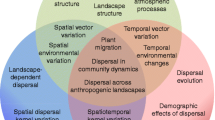Abstract
Seed and pollen dispersal are both important factors in the demography and population genetic structure of plant populations. How does one model and infer dispersal patterns? One approach is to map the locations of individuals in a population and use genetic information to suggest which parents generated which offspring. This article develops models and a maximum likelihood inference framework for data of this type. The procedure will be illustrated on data from a population of Chamaelirium luteum, an herbacious plant of the forest floor. This article shows how the proposed method avoids some of the problems found in the original analysis of these data. The approach also allows us to uncover some additional patterns in the data: differencesin the seed dispersal distributions between years.
Similar content being viewed by others
References
Clark, J. S., Macklin, E., and Wood, L. (1998), “Stages and Spatial Scales of Recruitment Limitation in Southern Appalacian Forests,” Ecological Monographs, 68, 213–235.
Hastings, W. K. (1970), “Monte Carlo Sampling Methods Using Markov Chains and Their Applications,” Biometrika, 57, 97–109.
Howe, H. F., and Smallwood, J. (1982), “Ecology of Seed Dispersal,” Annual Review of Ecology and Systematics, 13, 201–228.
Kass, R. E., and Raftery, A. E. (1995), “Bayes Factors,” Journal of the American Statistical Association, 90, 773–795.
Kass, R. E., and Wasserman, L. (1995), “A Reference Bayesian Test for Nested Hypothesis with Large Samples,” Journal of the American Statistical Association, 90, 928–934.
Meagher, T. R. (1981), “The Population Biology of Chamaelirium luteum, A Dioecious Lily. II. Mechanisms Governing Sex Ratios,” Evolution, 35, 557–567.
— (1986), “Analysis of Paternity Within a Natural Population of Chamaelirium luteum, I. Identification of Male Parentage,” American Naturalist, 128, 199–215.
Meagher, T. R., and Thompson, E. A. (1987), “Analysis of Parentage for Naturally Established Seedings of Chamaelirium luteum (liliaceae),” Ecology, 68, 803–812.
Metropolis, N., Rosenbluth, A. W., Rosenbluth, M. N., Teller, A. H., and Teller, E. (1953), “Equations of State Calculations by Fast Computing Machine,” Journal of Chemical Physics, 21, 1087–1091.
Mittal, M. M., and Dahiya, R. C. (1987), “Estimating the Parameters of a Doubly Truncated Normal Distribution,” Communications In Statistics—Simulation and Computation, 16, 141–159.
Schwarz, G. (1978), “Estimating the Dimension of a Model,” The Annals of Statistics, 6, 461–464.
Smouse, P. E., and Meagher, T. R. (1994), “Genetic Analysis of Male Reproductive Contributions in Chamaelirium luteum (L.) gray (Liliaceae),” Genetics, 136, 313–322.
Thompson, E. A., and Guo, S. (1991), “Evaluation of Likelihood Ratios for Complex Genetic Models,” IMA Journal of Mathematics Applied in Medicine and Biology, 8, 149–169.
Author information
Authors and Affiliations
Corresponding author
Rights and permissions
About this article
Cite this article
Jones, B. Maximum likelihood inference for seed and pollen dispersal distributions. JABES 8, 170–183 (2003). https://doi.org/10.1198/1085711031535
Received:
Revised:
Issue Date:
DOI: https://doi.org/10.1198/1085711031535




